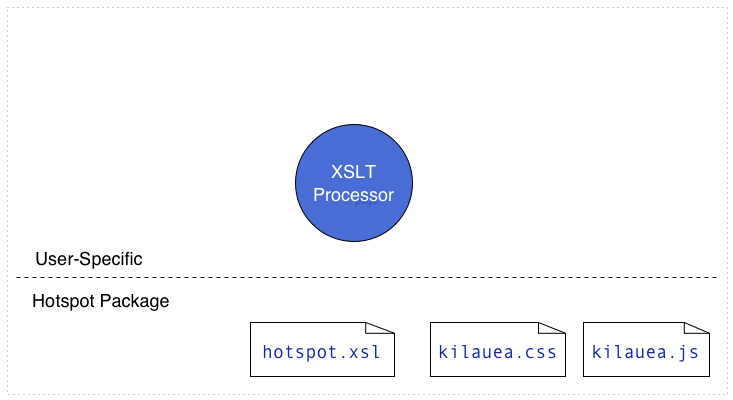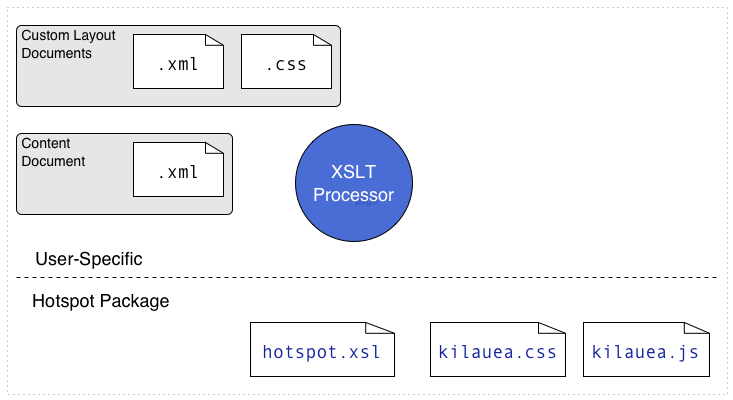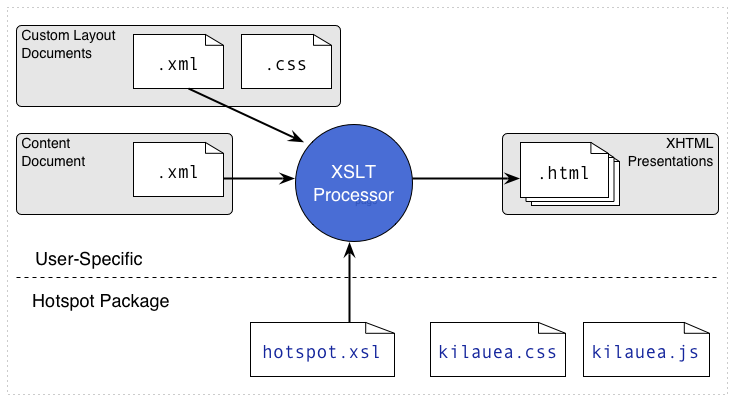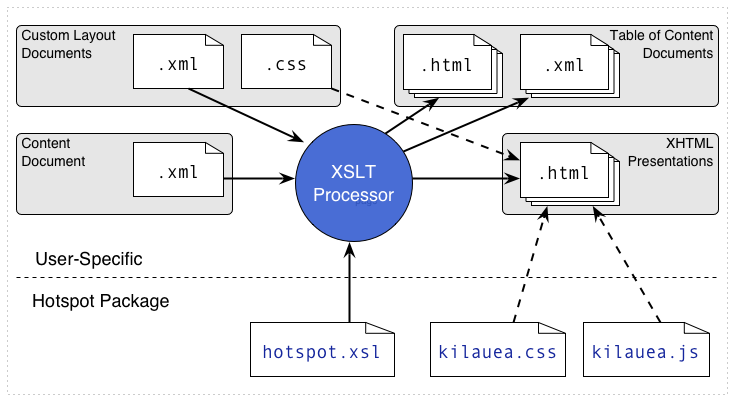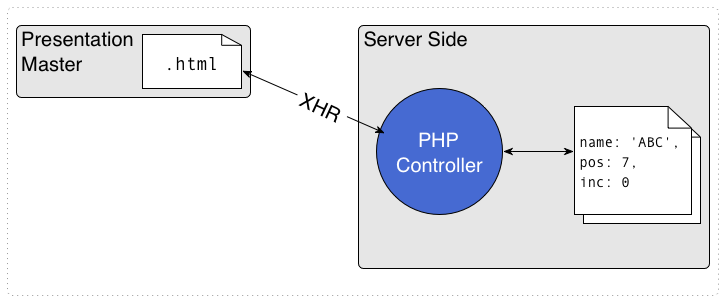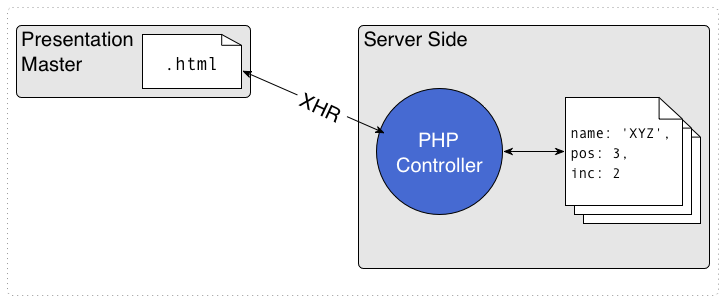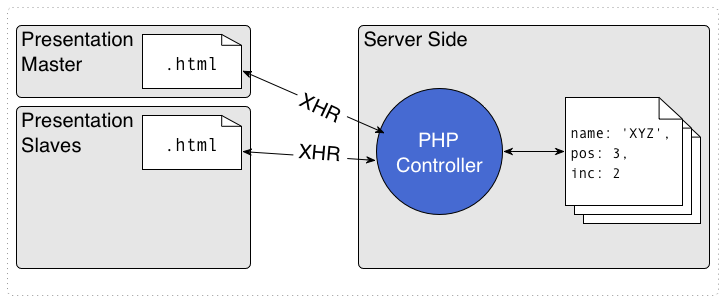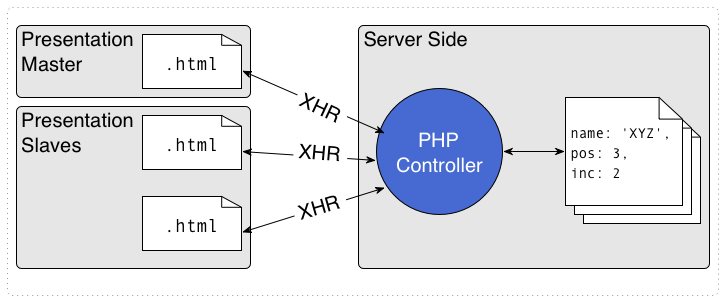Web-Based Presentations
XML-Tage Berlin 2007
Felix Michel, ETH Zürich
September 24, 2007; Berlin, Germany
Abstract
The management and publishing of complex presentations is poorly supported by available presentation software. This makes
it hard to publish usable and accessible presentation material, and to reuse that material for continuously evolving events.
Hotspot provides an XSLT-based approach to generate presentations out of a mix of general-purpose HTML and a small number
of presentation-specific structural elements.
Using Hotspot, the management and reuse of complex presentations becomes easier, and the results are more user-friendly in
terms of usability and accessibility.
Introduction
- We present Hotspot, a
- powerful,
- customizable,
- and extensible
- complex,
- structured,
- web-based
A Word of Precaution First
- We just re-baptized our project!
- XSLidy was based on Dave Raggett's Slidy, an XHTML slide show presentation application
- Now we use our own browser-based application, which is called Kilauea
- As the framework has nothing to do with Slidy any longer, we decided to rebaptize the project Hotspot
- You certainly noticed the semantic subtleties regarding the relationship between Hotspot and Kilauea…
Motivation
Outline (Motivation)
- Motivation [2]
- Hotspot [13]
- Hotspot Extensions [2]
- Kilauea [7]
Presentation Software Today
- Desktop applications: Microsoft's Powerpoint, Apple's Keynote
- Strengths:
- Posh & shiny layout templates
- Fancy transitions
- Deficiencies:
- Poor support for
- structured content
- content reuse / transclusion
- Impenetrable content models
- Customizing or extending the applications is hard
- Poor support for
- Web-based: S5, Slidy
- Since last week: Google Docs
Use Case Scenario
- Slideshow presentations for a university course
- A series of lectures
- → a bunch of related presentations
- Information usually appears in additional contexts:
- Course website
- Lecture abstracts
- Handouts
- Syllabi systems
- A series of lectures
- Furthermore, academic lectures are very likely to contain
- Cross-references
- Formulas
- Excerpts (e.g., sample code)
Hotspot
Outline (Hotspot)
- Motivation [2]
- Hotspot [13]
- Hotspot Extensions [2]
- Kilauea [7]
Hotspot
- One XML document for
- one or multiple presentations
- additional information (e.g., TOC and index preferences)
- Output is generated via XSLT
- Structured collection of presentations
- No redundant content
Apply changes once
Features: Listings
- Hotspot provides for transclusion of external documents
- The foundation of this feature is an XSLT-based implementation of XInclude, the XInclude Processor (XIPr)
- One application are listings,
the inclusion of excerpts (e.g., of source code):
<listing src=
The above listing results in the following HTML:berlin.xml
line=168-174
/><li>One application are <em>listings</em>, the inclusion of excerpts (e.g., of source code): <pre><listing src=<q>berlin.xml</q> line=<q>168-174</q>/></pre> The above listing results in the following HTML: <listing src="berlin.xml" line="168-174"/> </li>
Hotspot Extensions
Outline (Hotspot Extensions)
- Motivation [2]
- Hotspot [13]
- Hotspot Extensions [2]
- Kilauea [7]
FormuLaTeX
- The Formu
 extension brings the full power of
extension brings the full power of  to Hotspot
to Hotspot
 code can directly be inserted in
code can directly be inserted in <tex/>elements:<tex>$\calF{F}\{f(x)\} = F(u) = \\ \int_{-\infty}^{\infty}f(x)e^{-j2\pi{}ux}dx$</tex>- The Formu
 extension then produces image files and alignment information, and the formula looks...
extension then produces image files and alignment information, and the formula looks...
<img src=
...
alt=$\calF\{f(x)\} = ...
style=height: 5.37ex; vertical-align: -2.11ex;
/> - ...perfect:

Kilauea
Outline (Kilauea)
- Motivation [2]
- Hotspot [13]
- Hotspot Extensions [2]
- Kilauea [7]
Kilauea
- Browser-based slideshow presentations
- Implemented with Javascript and CSS
- Cross-browser operation
- No substantial browser-dependencies
Compatibility Chart:
Browser Version OS Firefox 1.5 OS X 10.3 2.0 OS X 10.4 Windows XP Linux Camino 1.0 OS X 10.4 Safari 2 OS X 10.4 Safari 3 beta OS X 10.4 Konqueror ? Linux Shiira 2.0 beta OS X 10.4 Opera 8.45 Linux 9.22 Linux OS X 10.4 MSIE 6 Windows XP MSIE 7 Windows XP - No plugins required
- No substantial browser-dependencies
Kilauea Features
- True hypertext:
- Structured content (including parts and sub-parts)
- Logical, not physical, markup
- Hyperlinks (link to parts, slides, and everything else)
- Flexible (wide variety of initialization configurations)
- Customizable (e.g., via CSS)
- Extensible (sophisticated plugin architecture)
- It is possible to embed presentations
Kilauea Javascript
- Localization support
- Small footprint (24 kB packed)
- Backwards-compatible with Slidy
- State-of-the-art Javascript:
- Inserts only one variable into the global symbol space
- Browser-independant, W3C-like event model
- → no problems with third-party Javascript
- Offers custom events (e.g.,
slideChangeevents)
Kilauea Plugin Architecture
- Plugins unleash the true power of Kilauea
- Plugin development is easy with Kilauea, but almost impossible for existing presentation software
- Extensive developer documentation eases plugin development
- Architectural details:
- Plugins are identified by URIs
- Object-oriented: each plugin is a class, which inherits some utility properties
- Plugins are loaded at run-time
- Currently available plugins include:
remote: Support for distributed, remote presentationslogger: Sophisticated logging facilitiesdoublescreen: Presentator mode with two browser windows
Logging Facilities
- Sophisticated logging and evaluation of presentations
- Export as HTML or CSV
Transitions
- Currently, we are working on a plugin which enables basic transition effects
- This might not seem to be very important, but it is a nice-to-have for moments like today's presentation
- Once the transition plugin has been included, transitions can be assigned to slides in a declarative way:
<div class=slide transition:fade</div> <h1>Transitions</h1> <ul> <li>Currently, we are working on a... ...
Outlook
- A rich-text editor will be indispensable in order to lower the barrier-to-entry for users
- Import from other formats (e.g., .ppt) would be nice, (but will be hard to implement)
- Better documentation, installation guidelines, and online help

